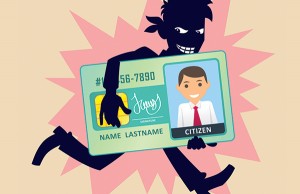Identity Theft: You and Your Child are at Risk!
No one ever expects to be a victim of identity theft. This summer, I got a reality check when my purse was stolen from my locked vehicle during a multi-car, smash-and-grab robbery. Unfortunately, Central Florida has seen a rise in such malice where criminals prey on vehicle owners who will be occupied for a period of time, such as at church, grocery stores, and gyms. According to the Bureau of Justice Statistics, 20% of victims who knew how their information was obtained cited a lost/stolen wallet. However, thieves can also take one’s identity by dumpster diving, change of address forms, mailbox theft, visual spying (looking over one’s shoulder ─ with the help of a smartphone ─ at bank/doctor’s office), ATM skimmers and overlays, mishandling of personal information (breach at office, etc.), phishing (including online, SMS/text, and voice/phone), and access through computer file sharing and online shopping.
 The 2013 Identity Fraud Report by Javelin Strategy & Research reports that, in 2012, identity fraud incidents increased by more than one million, and fraudsters stole more than $21 billion, the highest amount since 2009. WARNING: Children are a tempting target for identity thieves and can become victims from, for example, a stolen backpack or data breach at a school or recreation program. According to the Federal Trade Commission, more than 19,000 cases of child identity theft were reported in 2011, up from about 6,000 in 2003. Adults may suspect that they have been a victim of identity theft if: credit scores seem low, are denied financing, or are contacted by collection agencies. However, a child’s identity theft may go undetected for years ─ with serious consequences.
The 2013 Identity Fraud Report by Javelin Strategy & Research reports that, in 2012, identity fraud incidents increased by more than one million, and fraudsters stole more than $21 billion, the highest amount since 2009. WARNING: Children are a tempting target for identity thieves and can become victims from, for example, a stolen backpack or data breach at a school or recreation program. According to the Federal Trade Commission, more than 19,000 cases of child identity theft were reported in 2011, up from about 6,000 in 2003. Adults may suspect that they have been a victim of identity theft if: credit scores seem low, are denied financing, or are contacted by collection agencies. However, a child’s identity theft may go undetected for years ─ with serious consequences.
“In many cases, the key elements required to open a credit account is a name and Social Security number. Since a child’s Social Security number represents a ‘clean slate’ and has the potential to go undetected for years, it represents an appealing target to most identity thieves,” explains Julie Springer, vice president of consumer education at TransUnion, a national credit reporting company. “Identity theft can affect your child’s future credit and employment prospects if the perpetrator, who in many cases is a friend of the family or even a relative, obtains credit accounts using the child’s Social Security number.”
“The good news is there are steps parents can take to help minimize their child’s risk of becoming a victim, and signs to watch out for that could signal their child’s identity has possibly been compromised or stolen,” Springer says. To help safeguard your child, TransUnion advises:
- Be mindful of the information that your child carries and transfers.
- Remind children to never give out personal information, especially to a stranger, and only share with trusted persons.
- Consider hand-delivering forms containing personal/medical records to their school, instead of tossing them into a backpack.
Possible warning signs of child identity theft may include: 1) suspicious mail, like pre-approved credit cards and other financial offers that normally are sent to adults, addressed to child, 2) when trying to open a financial account for your child, you discover that one already exists or the application is denied because of a poor credit history.
The Social Security Administration has proclaimed identify theft to be among the fastest-growing crimes. TransUnion recommends managing personal information carefully and sensibly:
- Only carry essential documents. Your Social Security card, birth certificate, and passport are rarely required.
- Keep new checks out of the mail. Instead, pick them up at the bank.
- Be cautious with phone communication. Do not give out personal information unless you initiated the call.
- Don’t make trash a thief’s treasure. Shred receipts, card offers, statements, and returned checks before throwing away.
- Make sure others are keeping you safe. Ensure that your employer, landlord, etc. uses data properly.
- Stay on top of your credit. Ensure reports are accurate and consider a credit monitoring service.
- Know your billing cycles. Thieves can start by changing your billing address, so track statement arrivals.
- File account numbers, expiration dates, and phone numbers. If your wallet is stolen, you’ll be able to quickly alert your creditors.
- Create passwords/PINs with a random mix of letters & numbers. Doing so makes it harder to crack codes, and easier for you to prevent identity theft.
As a victim of a smash-and-grab robbery which has compromised my identity, I stress the importance of never leaving valuables, such as purses, in your car ─ even if covered or hidden (as thieves may watch where you place belongings). If you are, or suspect you may be, a victim of fraud or identity theft, credit bureaus, like TransUnion, can place a Fraud Alert or Credit Freeze on your credit report to alert potential creditors or lenders and, once alerted, take steps to protect you.
Child ID Theft by the Numbers
- 334 days: Average time to detect a case of child identity theft.
- 56%: The percentage of child identity theft cases involving a stolen Social Security number.
- 27%: The percentage of reported child identity theft cases that were perpetrated by a family member or friend!
- 1-in-40: Number of households with children under 18 that experienced child identity theft.
Source: 2012 Child Identity Theft Fraud Report by the Identity Theft Assistance Center








